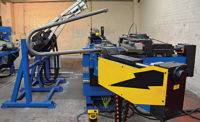Although it’s one of the world’s largest manufacturers of construction machinery, the Liebherr Group believes strongly in decentralization. Each of its 130 worldwide companies operate as an individual entity. The products they manufacture are diverse and include cranes, earth-moving equipment, machine tools, automation systems, refrigerators and freezers.
For the last several years, Liebherr has been the world’s largest crane manufacturer. One of the company’s largest crane-manufacturing plants is Liebherr-Werk Nenzing GmbH in Nenzing, Austria. The factory produces deck, offshore, crawler and mobile-harbor cranes; reach stackers; hydraulic cable excavators; and pile-driving and drilling equipment.
Prior to 2012, welding of intermediate sections for crane booms was done manually. This arduous work required welders to weld large numbers of tubes while standing in uncomfortable and dangerous positions. Looking to improve working conditions and increase productivity, plant managers installed two fully automatic robotic welding cells a few years ago.
“We wanted a fully automated robotic welding system that could accommodate around 50 different variants of crane booms,” recalls Tobias Stroehle, head of equipment production for Liebherr-Werk. “With this state-of-the-art technology, we are setting new standards for productivity and reproducible quality.”
Welding experts at Yaskawa Europe’s Motoman Robotics division developed the cells. Each features two robots that handle the parts and two more that weld booms from 3 to 12.5 meters long, 0.9 to 3 meters wide and weighing up to three tons.
A crane boom consists of four longitudinal chord tubes, which, together with the horizontal posts and bracing, form the basic frame. Several diagonal tubes are welded in between these chord tubes to reinforce the structure.
Six-axis Motoman ES165 and ES200RN robots handle tubes and parts, while six-axis EA1900 robots perform all tack and final welding. The ES200RN is mounted on a linear axis that runs along the length of the system, linking the welding station and the workpiece supply area.
After the cell operator places all chord and diagonal tubes in the positioning table, the fully automated process begins. The ES165 robot loads a diagonal tube into a measuring station, where cameras inspect the tube and precisely measure the contours of its cut ends. Simultaneously, supporting and locating fixtures ensure exact positioning of the four chord tubes.
The ES200RN robot grabs the diagonal tube and transfers it to the first loading position in the welding area. There, the diagonal tube is inserted between the four chord tubes from below. To achieve this, the robot must be agile and precise: opening its gripper upon reaching the target coordinates and gently shaking the diagonal tube into the desired position.
While the EA1900 robots converge and tack weld this diagonal tube, the two handling robots move the next diagonal tube into position. Once all the tubes in one plane have been tack welded, the positioning table indexes the workpiece to the next section.
After the diagonal tubes are MIG welded, all small components are tack and final welded. Finally, the operator inspects and unclamps the finished intermediate section.
For more information on handling and welding robots, call 937-847-3200 or visit www.motoman.com.





